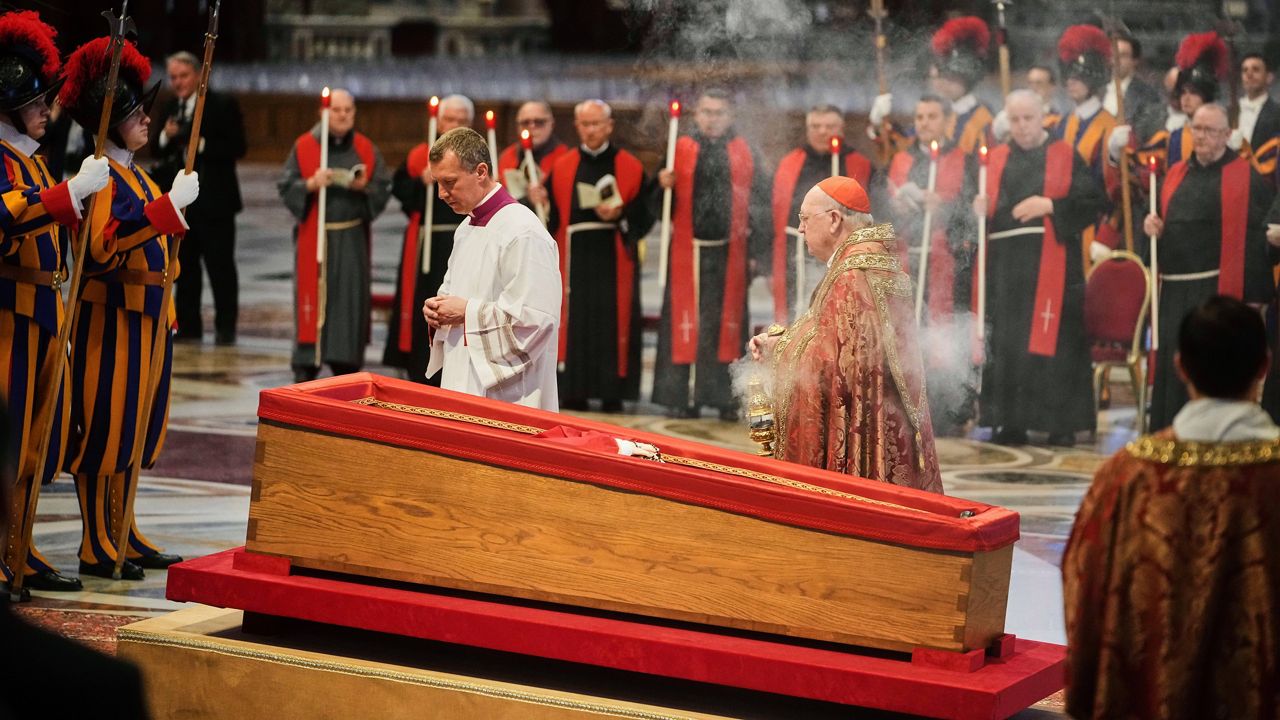The photographs that show Pope Francis lying in his coffin, lifeless, disclose a great deal more than what is initially apparent, and each and every aspect conveys a narrative.
By his own decision, the late pontiff’s final resting exhibit deviates from centuries of Vatican custom in a number of ways, including the adoption of an unconventional casket and the placement of personal artifacts alongside his body.
As the entire world says goodbye to Pope Francis, the upcoming funeral of the pope will be a reflection of the fundamental principles that he fought for during his entire life. It is a tremendous monument to the legacy that Pope Francis leaves behind that his ultimate burial place be named after him. Pope Francis is known for his simplicity, humility, and unfailing caring for those who are marginalized.
In addition, the personal objects that he selected to bring with him will serve as a final remembrance of a life that was devoted to acts of kindness, love, and transformation.
After suffering a catastrophic stroke that resulted in permanent heart failure, the beloved pontiff, who was 88 years old, passed away on Monday. The Argentine-born spiritual leader passed away in peace at the Vatican after a prolonged battle with pneumonia that lasted for several weeks.
What exactly is in the casket of the Pope?
The first dramatic photographs of Pope Francis sleeping in repose were released by the Vatican on Tuesday. The photographs revealed the significant items that were prepared for him to take with him on his last journey.
His coffin, which was guarded by ceremonial guards, stood in silence while members of his household and officials from the Vatican joined together for a solemn and respectful farewell.
In the photographs that have been made public, Francis is depicted lying in an open casket while wearing crimson vestments. This hue is often used to represent martyrdom and the blood of Christ. His hands are softly folded across to accommodate a rosary.
Along with his mitre, which is the traditional papal hat, his crozier, which is the pastoral staff, and a collection of coins that were coined during his papacy, which is a ritual that dates back hundreds of years and symbolizes his time as the Vicar of Christ, are also placed inside the casket.
There is also a rogito, which is a sealed legal document that provides a summary of his life and pontificate, contained within the coffin. It is customary to shatter the Fisherman’s Ring in a ritualistic manner prior to burial in order to mark the conclusion of a pope’s reign. The Pope is currently wearing the broken Fisherman’s Ring on his right hand.
Due to the fact that the ring was initially intended to serve as a seal for the pope’s personal letters, the destruction provides the additional purpose of ensuring that it cannot be appropriated for any purpose after the pope’s passing.
An examination of the casket
Taking a quick look at Pope Francis’s casket is all that is required to understand how his passing represents a significant break from the long-standing customs that have been associated with papal funerals.
The past popes, such as the late Pope Benedict, were laid to rest in elaborate triple coffins composed of cypress, lead, and oak. Francis, on the other hand, opted for simplicity in his burial arrangements.
His coffin is a simple timber structure that is lined with zinc, which reflects his dedication to serving others with humility. The customary papal goodbye, in which the body of the Pope would be laid on a catafalque inside St. Peter’s Basilica for the sake of public mourning, has also been abandoned.
Instead, the lid of the coffin will be lifted, and Francis’s body will be placed inside the casket. This will allow mourners to pay their respects in a manner that is more personal and emotional.
At the same moment, a pope will be laid to rest outside of the Vatican for the very first time in more than a century.
Instead of being laid to rest in the grottoes beneath St. Peter’s, where the graves of approximately 90 popes are housed, Pope Francis will be laid to rest at the Basilica of Santa Maria Maggiore, which is located in the Esquilino suburb of Rome.
Where and when will the funeral take place?
It has been announced by the Vatican that the burial for Pope Francis would take place in St. Peter’s Square on Saturday, April 26 at ten o’clock in the morning the local time.
The remains of the deceased will be transferred to the Basilica of Santa Maria Maggiore, which is located in the Esquilino suburb of Rome, following the public service. This is the same location where Francis had previously expressed his desire to be laid to rest.
The body of the deceased will be placed in state at St. Peter’s Basilica beginning on Wednesday. In the moment that the body is being brought into the basilica, the mournful chant of the Litany of Saints will fill the air. The camerlengo, who is at the forefront of the procession, will lead the singing. Catholic Cardinal Kevin Joseph Farrell, who was appointed to the position of camerlengo by Pope Francis in 2019, is now serving in that capacity.
The remains of Pope Francis will not be placed on an elevated bier, which is a departure from the long-standing ritual that has been followed. Instead, his plain wooden coffin is placed on the floor. It is facing the pews, and the Paschal candle is placed nearby. This candle is a modest sign of faith and light.
The small, intimate touches, such as his humble wooden casket and the ceremonial that was kept to a minimum, are the ones that speak the loudest as the world continues to grieve the loss of Pope Francis.
He opted to live his life with compassion, simplicity, and a break from tradition, and he did the same thing in death. Furthermore, it is possible that such decisions will define his legacy more than any big procession could ever hope to do.


